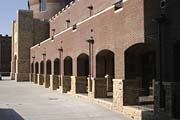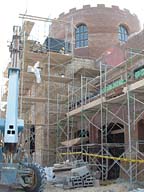

The use of stone, in addition to the school's red brick, was intended to allow the Sandy Beaver Center to become the focal point within the main courtyard on campus. According to Architect Laurie Canup of Atlanta-based Lord, Aeck & Sargent, the school's superintendent, Col. Michael Hughes, wanted the building to match the style of the surrounding buildings, but at the same time, be more expressive and inspirational.
The base of the center and the entry tower are comprised of Tennessee Chopped Stacked Stone with a random rubble stone coursing. According to Canup, several types of stone were considered before making the final decision, and they chose the regional stone because it worked well with the color palette that was already in place at the school. The stone was also chosen to provide a softer look and to add life to the building.
Pike Family Nursery, headquartered in Norcross, GA, supplied the 250 tons of stone, which were typically 4 to 8 inches in size, and quarried in Tennessee. The stacked stone contains shades of brown and gray at the surface, and tan, pink and brown on the inside. Quarried stacked stone is a chopped and broken flagstone, and is typically 3 to 6 inches thick.
“We made several visits to the supplier's yard to narrow down our choices,†said Canup. “Once the choices were narrowed down, we had a few mock-up panels built on-site, which included the stone options and the surrounding materials. This allowed us to see the palette of materials in the built form, with the coursing, raking of the joints, and various mortar color options. All of these items played into the decision of which stone to use.â€
According to Mark Erbesfield, president of PaverStone Construction in Atlanta, GA -- the installers on the job -- a lot of handwork and production was required on location. “Our client wanted the stone faces to remain as natural and rough as possible while still maintaining a very specific coursing and pattern,†he said. “All of the stone was delivered to the site as raw bulk material, either chopped or strip rubble. Our masons would then handwork the individual stones into square- and rectangular-shaped pieces prior to installation to achieve the look the architects desired. The masons would then install the handworked stones into the random rubble customized pattern. Some of the raw stone was 2 feet long and we would cut them up to create the size and shape to allow the random rubble pattern to flow.â€
The architects worked with the masons to ensure the final installation would match the desired look. “We were very concerned about the size and scale of the project and felt that consistently using pieces of stone smaller than a brick would not be appropriate for the scale of the building,†said Canup. “We worked closely with the stone masons to ensure that large pieces of stone were consistently used, keeping the scale of the stonework appropriate to the larger size of the building.â€
PaverStone completed the installa-tion in approximately nine months, with six workers on the job. Cast stone was also used to detail transitions to doors, windows and brick work, which enabled a clean transition between the rough stone surfaces to smoother surfaces.
The building also includes a 40,000-volume library and reading room, a 770-seat theatre/auditorium, art and photography classrooms, and instru-mental and choral rehearsal rooms.
Since opening, the Sandy Beaver Center has received positive reviews. “The building's design, from the wood-paneled library to the art studios with a pristine view of the North Georgia mountains, has a reverent and collegial quality that is conducive to quiet, focused study and creative expression,“ Hughes said. “It is designed for maximum academic performance.â€

End box
Sandy Beaver Center for Teaching and Learning, Riverside Military AcademyGainesville, GA
Architect: Lord, Aeck & Sargent, Atlanta, GA
Installer: PaverStone Construction, Atlanta, GA
Supplier: Pike Family Nursery, Norcross, GA